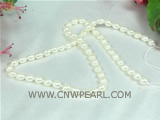There are two types of pearls–natural and

1. There are two types of pearls–natural and cultured. In today’s market just about every pearl you see will be cultured, i.e. the hand of man had something to do with manufacturing the pearl.
2. We are experiencing a pearl renaissance. There are more types of pearls on the market than ever before. Twenty years ago the Japanese Akoya stood virtually alone. Today you can choose from: Freshwater pearls, South Sea white, Tahitian black, and South Sea golden pearls.
3. What’s the best buy in pearls? The Chinese Freshwater Pearl. These pearls are cultured without a bead and are pure pearl. They are available in natural pastel or white. The best will stand toe-to-toe with any pearl in the world, and can be purchased for a third of the price.
4. Pearls are often treated, usually to change or improve the color. Natural colors are, by far, the most beautiful. Japanese Akoya, the pearl that is seen most in the market, is routinely bleached white, then dyed, to give it a pinkish overtone.
5. A fine pearl has what experts call “life”. This is a combination of high surface luster and overtone, an ephemeral misty glow that seems to hover over the surface of the pearl. In white pearls the overtone will normally be pink. In black pearls, the overtone will be green, red or blue. Look at the pearl(s) under a light bulb; if you can distinctly see the outline of the bulb, the pearl has high luster.
6. To judge if all the pearls in a strand are round, hold the strand taut between your hands and rotate the strand; if some of the pearls jump about, the strand is not completely round.
Are you familiar with jewelry?
Tags: black pearls, golden pearls, guangzhou city, largest jewelry, tahitian black
